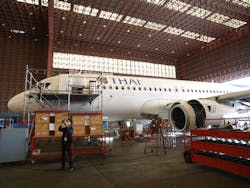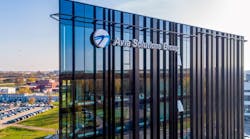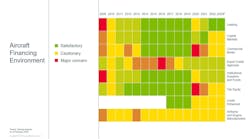Over the past 30 years, the airline industry has grown worldwide exponentially driven by the strong global travel demand. According to the 2015 Global Market Forecast Report by Airbus, passenger air traffic has doubled every 15 years since the early '80s, and is expected to further grow at an average annual rate of 4.6 percent over the next 20 years.
In the Asia-Pacific region there seems to be room for considerable growth, based on the forecast of a 20-year growth rate at 5.7 percent yearly. According to the forecast, the Asia-Pacific region will account for 36 percent of the world’s air traffic, increasing from 29 percent in a year in 2014. Given its growth potential and budding opportunities, many international aerospace companies are looking to expand and locate their business in the Asia-Pacific region. Thailand is set to grow and benefit from the rising demand in global aviation thanks to its available skilled human resources, its geographical advantage, and strong government support. The country is on its way to becoming Asia’s premier aviation hub, and a full-service leader in the aerospace industry.
Thailand’s Domestic Market Expansion
Thailand’s aviation growth is experiencing rapid expansion, as many global aviation subjects shift their attention to the Asia-Pacific region. According to the Air Transport Information Division of AOT (AOT, Airports of Thailand Public Company Limited), total air traffic in Thailand increased by 21 percent from 2014 to 2015, aircraft movement increased by 17 percent, and passenger numbers by 21 percent. In value terms, this generated an increase of about $167 million U.S. of revenue to the country. According to the AOT information, the increase in air traffic was driven by the expansion of Thailand’s tourism industry and low-cost airlines. In 2015, a total of 23 million tourists traveled to Thailand by air, which is an increase of 21 percent, compared to 19 million tourists in 2014. Low-cost airlines in Thailand contributed with around 30 percent of the market share; low-cost aircraft movement increased by 29 percent, while passenger numbers increased by 34 percent from 2014.
MRO Sector Largely Untapped
The MRO business in Thailand still has great room for growth. This was witnessed even by the AviationPros team during the July 2016 visit to Thailand. According to the Thailand's Office of Transport and Traffic Policy and Planning (OTP) and to Ministry of Transport, total MRO expenses from 2015 to 2024 are estimated to be about U.S. $167 billion (THB 5,990 billion) in the Asia-Pacific region. About 6.3 percent of that expenditure will occur in Thailand; it generated in 2015 an MRO income of about U.S. $772 million (THB 28 billion). Up to U.S. $10.6 billion (THB 380 billion) is forecasted for the next 10-year period.
Aerospace Industrial Estate Development Plan 2016-2045
The government’s recognition of the opportunities that lie in Thailand’s aerospace sector has led to the implementation of the Aerospace Industrial Estate Development Plan (2016-2045) at the new U-Tapao-Pattaya International Airport. This - former military used airport - is now being adapted for needs of tourism, and will serve the region south of Bangkok. Its official opening is scheduled for Jan./Feb. 2017 with soft opening by late summer 2016.
This Aerospace Development Plan is currently being executed in three phases, where the Aerospace Industrial Estate will utilize a total of 197 acres (80 hectares) of land; 60 percent will be dedicated to OEMs (original equipment manufacturers) and 40 percent to the MRO sector. At present, the focus is on Tier 3 component manufacturing and Tier 4 composite manufacturing for OEMs. As for MRO facilities, the present focus is on servicing airframes, engines, and their components. The top five components expected to bring in the most capital in Thailand are: Landing gear & wheels, auxiliary power units (APUs), in-flight entertainment components (IFE), engine fuel and control, and landing gear.
Thailand Offers Multiple Advantages
Aside of the tax and non-tax incentives provided by Thailand’s Board of Investment (BOI) that is a main partner and help source for potential investors, foreign investors can also benefit from many of Thailand’s strengths in the aviation industry. Thailand has abundant land availability for the expansion of its booming aerospace industry and skilled labor at competitive costs is available, specially compared to other Asia-Pacific countries. Plenty of highly skilled labor is available in Thailand, trained in institutions that offer degrees in aerospace engineering, such as the Civil Aviation Training Center (CATC) and over 60 private and public universities.
Thailand’s location in the ASEAN Economic Community (AEC) and the Thai airline industry’s solid connections to corresponding airline industries in ASEAN, presents investors with manifold opportunities in the MRO business. Thailand has further, a well-established aerospace industry base and excellent linkage to automotive and electronics industries. Companies that have already invested in Thailand include among others Airbus, Senior Aerospace (former Weston Aviation), Saab Thailand, Chromalloy, Triumph Aviation Services, Leistritz, Zodiac Aerospace, and GKN Aerospace.
Forward thinking investors have in Thailand a ready base for taking advantage of the strong growth in Asia-Pacific’s aviation industry, and can expect to reap great economic benefits.
In July 2016 the AMT crew was able to visit one of Thailand's leading developers of industrial estates, the Hemaraj.
Hemaraj Land and Development PLC
Hemaraj Land And Development Public Company Limited, established in 1988, is Thailand’s leading developer of industrial estates, utilities, power, and property solutions. Hemaraj develops eight + industrial estates in Thailand on 18.079 acres land. Hemaraj's industrial customers - a total count is 673 - are from the automotive, petrochemical, and other fields. Beside utilities like water and power Hemaraj develops 85.000.000 square feet of ready built factories and logistic parks. Hemaraj is offering ready built factories for lease or for purchase but is also offering only land for sale and is able to build industrial sites to customer specification. Hemaraj is since 2006 Thailand's No. 1 building-to-suit logistics facilities developer and was acquired in 2015 by WHA Corporation and is working toward becoming one-stop service for reputable partners. (PDF page # 5 and 6).
The Hemaraj sites are conveniently located across Thailand in proximity of international airports Suvarnabuhmi/Bangkok, U-Patao serving Pattaya/Rayong region and close to Bagkok Port and Laem Chabang deap sea port. All their industrial estates are located conveniently close to Thailand's free trade zones. Hemaraj has in its portfolio Saraburi Industrial Land estate – this cluster is being promoted with BOI investment programs. This site is located 70km from Bangkok and is being developed on 1.448 acres total area where the Phase 2 is not yet developed, thus with ample growth possibilities. For more information visit www.hemaraj.com or www.wha.co.th.
BOI
The Office of the Board of Investment (BOI) is the principal government agency that operates under the Prime Minister's Office for the purpose of encouraging investment in Thailand and serves as the professional contact point for investors, providing them with useful investment information and services. In addition, the BOI offers business support and investment incentives to foreign investors in Thailand, including tax and non-tax incentives. A few non-tax incentives include granting land ownership to foreigners and facilitating visas and work permits. Besides serving the needs of overseas investors, the BOI also offers consultation services to Thai investors who are interested in investment opportunities abroad as BOI has representatives in the U.S. and across Europe.
BOI introduced a new scheme according to which aerospace related activities are eligible for additional incentives if based in one of 14 Super Clusters and if they meet certain obligatory conditions. One of the obligatory conditions is the cooperation with academic or research institutions and investors are required to apply for incentives in 2016 and begin operations in 2017. Investors meeting all conditions are eligible to be granted Super Cluster incentives such as an eight-year corporate income tax exemption and an additional five-year reduction of 50 percent. Personal income tax exemption will be granted for renowned specialists working in specified areas. For future industries of significant importance, the Ministry of Finance will consider granting 10-15 years of corporate income tax exemption. Activities like repair or manufacturing of aircraft, engines or of its parts are eligible to receive incentives. Those activities need to be approved by related agencies. For more information visit www.bio.go.th.
*AOT, Airports of Thailand Public Company Limited (Plc), or AOT, was established from the corporatization of the Airports Authority of Thailand, a state enterprise. It became a public company on 30 September 2002, with a total registered capital of THB 14,285,700,000, divided into 1,428,570,000 ordinary shares at a par value of THB 10. The Ministry of Finance is the largest shareholder with a 70 percent stake, with the other 30 percent held by institutional and retail investors. AOT's head office is located at 333 Cherdwutagard Rd., Don Mueang, Bangkok 10210. Its telephone number is 66 (0) 2535-1111.


